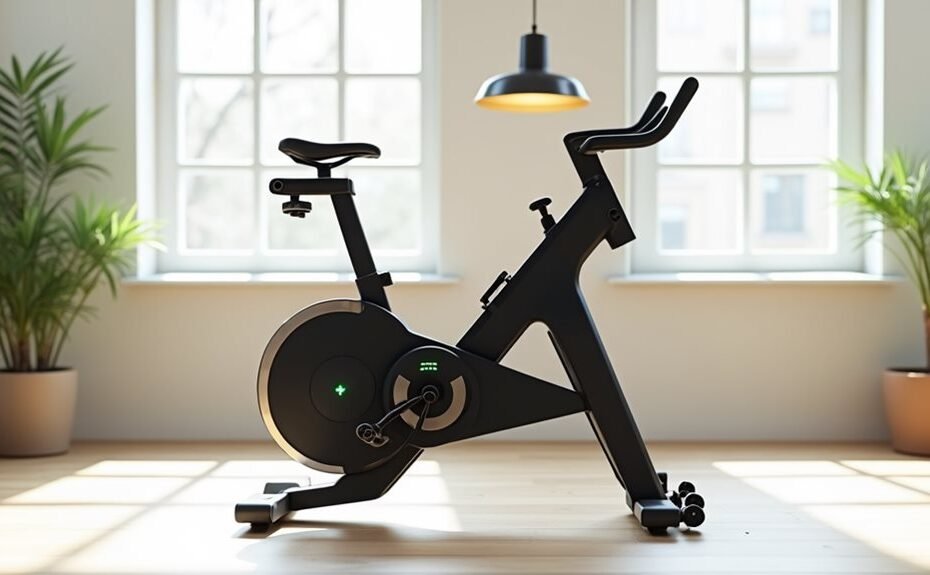I've spent years testing various static bikes, and I can tell you that self-powered models are transforming home fitness in ways I never expected. As someone who initially doubted the practicality of equipment that generates its own electricity, I'm now convinced these bikes represent the future of sustainable exercise. They're not just about pedaling – they're sophisticated training tools that combine power generation with performance tracking. Whether you're a data-driven athlete or an eco-conscious fitness enthusiast, there's something compelling about turning your sweat into clean energy. Let me show you what makes these bikes truly special.
Key Takeaways
- Self-powered bikes generate electricity through pedaling, potentially powering electronic devices after workout sessions.
- These bikes require no external power source, making them eco-friendly and suitable for off-grid training locations.
- Most models feature performance monitoring systems that run on user-generated power during workouts.
- Users can participate in virtual training sessions and global fitness communities while generating their own power.
- Self-powered bikes typically combine magnetic resistance systems with power generation capabilities for optimal workout efficiency.
Understanding Static Bike Types
Today's static bike market offers four main categories to match different fitness needs and lifestyle preferences. Let me break down each type so you'll know exactly what you're getting into.
Indoor cycling bikes are your classic spin-class warriors – they'll have you leaning forward like a road cyclist, with resistance you can crank up until your legs scream. I love their versatility for both seated and standing workouts. These high-performance bikes typically require 10 square feet of space.
Upright bikes keep things traditional, positioning you vertically with pedals under your feet. They're compact, efficient, and perfect if you want a straightforward workout. Air bikes provide endless resistance levels for intense cardio sessions.
Don't overlook recumbent bikes if joint health is a concern – they're essentially workout chairs with pedals, offering vital back support and reduced impact.
Choosing Your Resistance System
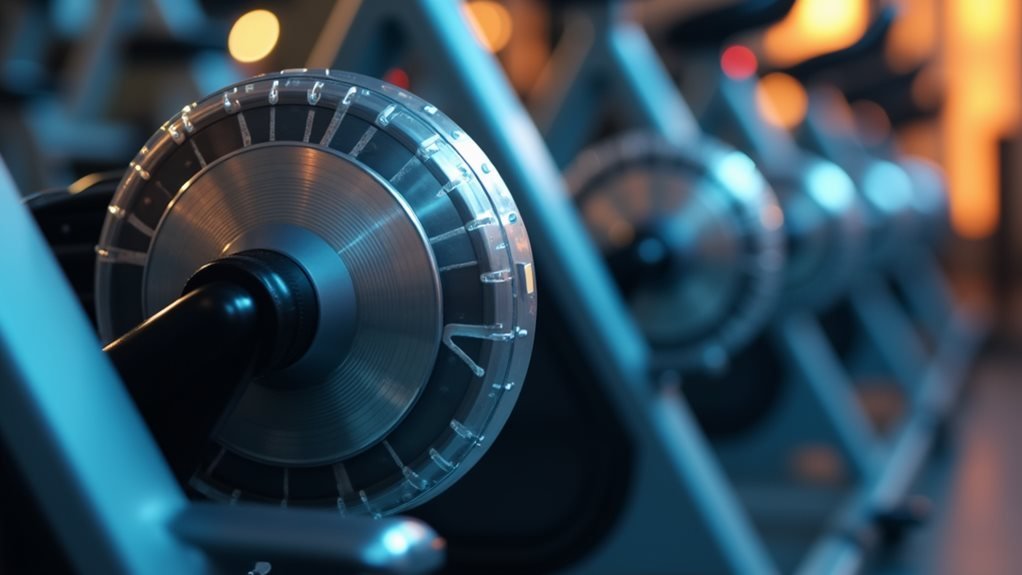
When selecting a resistance system for your static bike, understanding the key differences between magnetic, air, direct-contact, and hybrid systems will shape your entire workout experience. I'll help you cut through the noise and focus on what matters.
Magnetic resistance is your silent warrior – perfect if you're working out at home and don't want to wake the kids. With up to 32 resistance levels on models like the Echelon Connect, you'll get smooth, consistent workouts without needing a power supply. The Bluetooth connectivity features make it easy to join online fitness classes. Manual micro-adjustments allow for precise customization of your ride intensity.
Air resistance is my go-to for serious athletes. You'll crush those high-intensity sessions with up to 2500 watts of peak power on systems like the Wattbike Air. Trust me, it's worth the investment if you're training for performance.
Direct-contact systems are your gym-grade workhorses. Take the Schwinn 800IC – 100 levels of resistance that'll make you question your life choices (in the best way possible). They're built like tanks and can handle whatever you throw at them.
Need flexibility? Hybrid systems combine the best of multiple worlds. You'll get self-generating power, digital integration, and varied resistance mechanisms all in one package.
Core Features That Matter
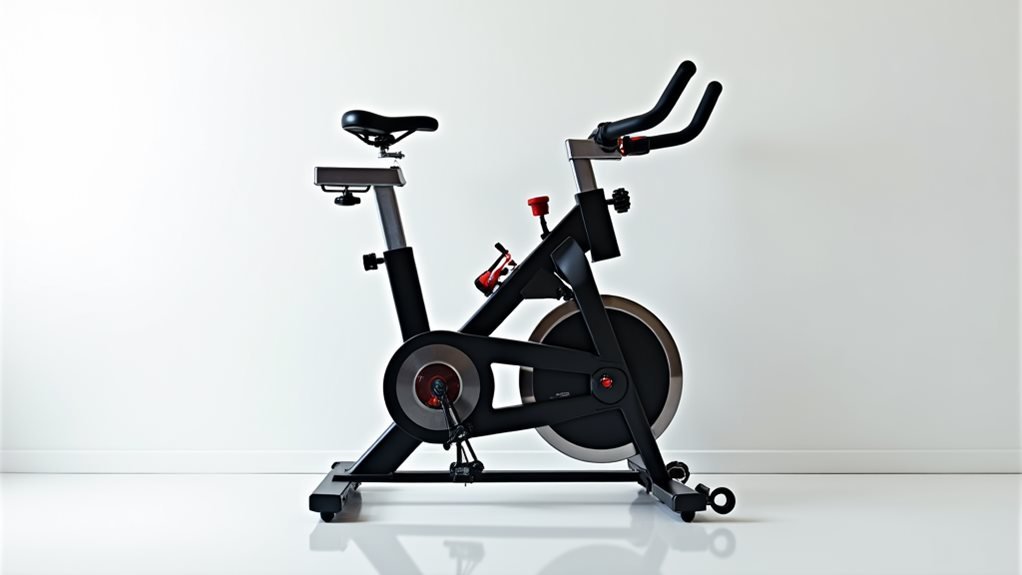
Getting the core features right on your self-powered static bike can make or break your training experience. I'll tell you exactly what matters: start with frame quality – you need a powder-coated steel beast that'll handle whatever you throw at it. Don't mess around here; look for weight capacities of at least 300 pounds. For those focused on weight loss, choose an upright bike model that maximizes calorie burn.
The CAROL bike delivers scientifically-proven results with just two 20-second sprints per session. Ergonomics aren't just fancy marketing speak – they're your best friend during those long training sessions. I insist on adjustable everything: handlebars, seat height, and position. Trust me, your back will thank you. And those dual-sided pedals? Non-negotiable for serious training.
Let's talk tech because it's 2024, not 1984. Your bike needs solid performance monitoring – speed, distance, heart rate at minimum. I won't compromise on connectivity either; your bike should play nice with fitness apps and external devices. It's not just about the ride anymore; it's about tracking progress.
Safety features aren't optional extras – they're essential. I'm talking magnetic brakes, freewheel clutches, and proper warning systems. Remember: a smooth, silent ride isn't just luxury – it's about sustainable, injury-free training.
Maximizing Your Workout Results
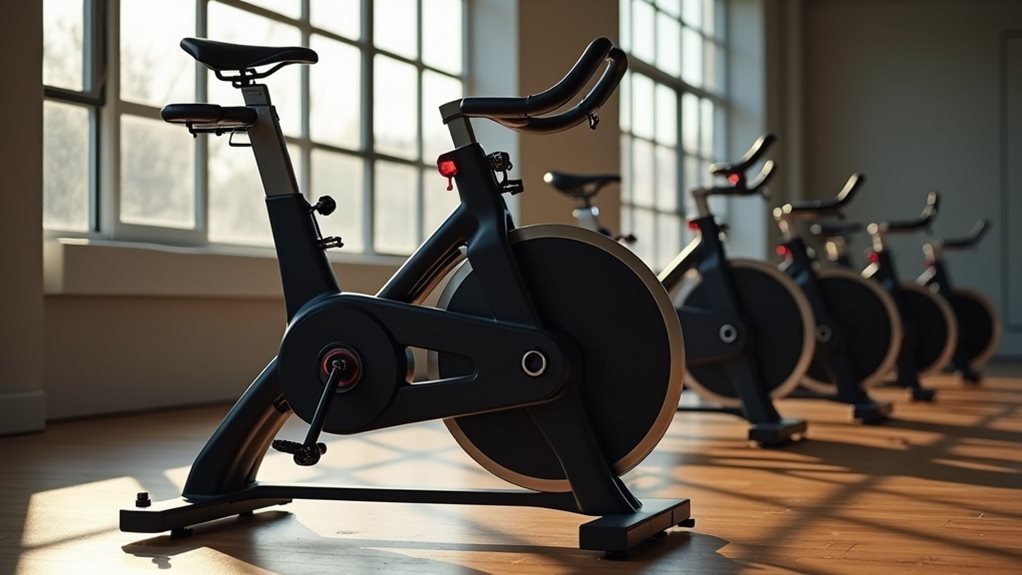
Now that you've got a bike with all the right features, let's focus on making every pedal stroke count. I'll tell you straight up – resistance is your best friend here. Crank it up strategically to build strength and endurance, but don't go overboard. You need the right level for your fitness to trigger those essential hormonal responses. You can burn 500 calories in a single session with the right intensity.
I'm a huge fan of HIIT workouts on static bikes because they're ruthlessly efficient. Try this: 30 seconds at maximum effort followed by 30 seconds at a moderate pace. Repeat until you're questioning your life choices (or for 20 minutes, whichever comes first). Trust me, these short, intense sessions are just as effective as those mind-numbing hour-long slogs. A stationary bike's adjustable features allow you to precisely control your training targets.
Look, let's address the elephant in the room – static bikes aren't perfect. They won't give you the core workout of outdoor cycling, and yes, you might get bored. But here's the fix: mix up your routines, combine them with strength training, and keep adjusting your resistance.
Focus on maintaining proper form, and you'll crush your fitness goals faster than you can say "cardiovascular improvement."
Build Quality and Longevity
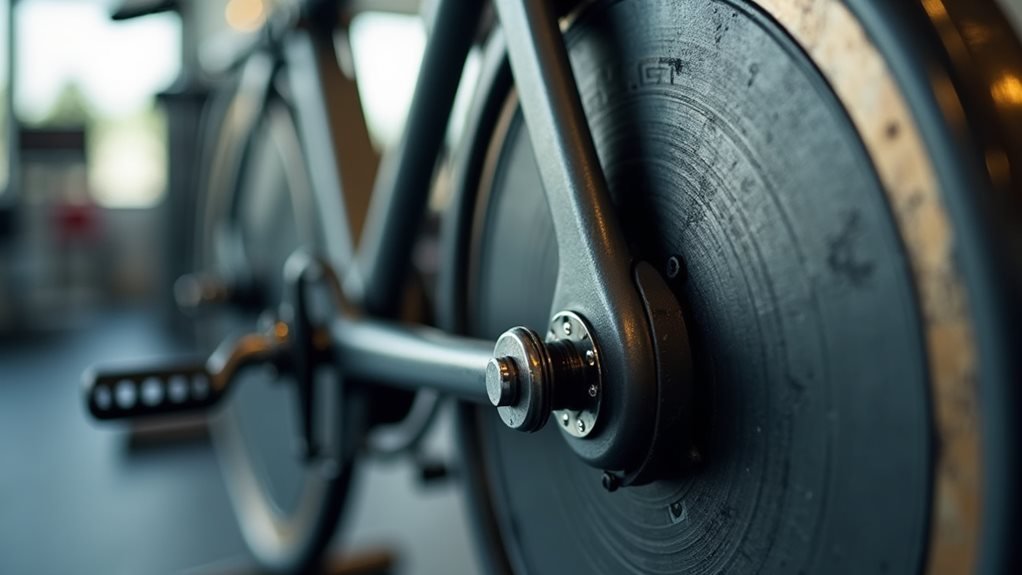
The durability built into modern static bikes comes down to thoughtful engineering. I'll tell you straight up – these aren't your grandmother's exercise bikes. Modern manufacturers have cracked the code on longevity by focusing on three critical areas: frame construction, drive systems, and weight capacity.
Let me highlight what separates the reliable bikes from the junk:
- High-quality steel frames that'll handle up to 330 pounds of user weight
- Belt-drive systems that slash maintenance needs and operate whisper-quiet
- Heavy-duty flywheels (we're talking 36-49 pounds) for rock-solid stability
Listen, I've seen enough exercise equipment to know what lasts. These bikes are built with corrosion-resistant components and friction-based or magnetic resistance systems that won't quit on you. The fan resistance option provides direct resistance based on your pedaling speed. The magnetic resistance systems, like those found in the Echelon Ex-3, deliver near-silent operation for peaceful workouts.
The wide bases keep you stable during those high-intensity sessions, while the adjustable components accommodate different body types without compromising structural integrity. Trust me – when you're pushing through a grueling workout, you'll appreciate the mini roller wheels for easy movement and the multi-position handlebars that let you dial in your perfect fit.
This isn't just about lasting longer; it's about performing better.
Smart Technology Integration Benefits
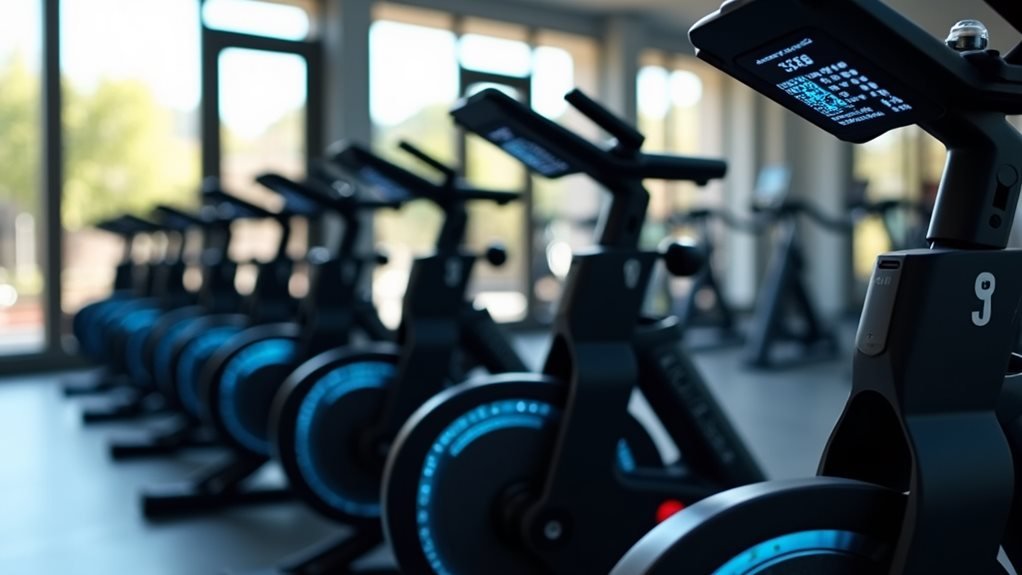
Thanks to rapid advances in smart technology, modern static bikes have transformed into interactive fitness powerhouses. I'll show you how these machines deliver a workout experience that's both data-driven and engaging. Connect to apps like Zwift or Peloton Digital, and you're instantly part of a global fitness community, complete with virtual training sessions and friendly competition.
Let's talk numbers – these bikes track everything. Your heart rate, power output (accurate to 1%), and even pedaling efficiency are monitored in real-time. I've seen users transform their workouts using this data, especially when the bike automatically adjusts resistance based on their performance metrics.
But here's the kicker – some models are actually generating power while you sweat. One hour of pedaling produces enough juice to run your laptop for four hours. You're not just burning calories; you're creating clean energy. Connect your bike to entertainment apps, join virtual group rides, or compete for badges – whatever keeps you motivated.
The consistent software updates guarantee you'll never run out of new features to explore. It's fitness meets technology meets sustainability, and it's revolutionizing home workouts.
Best Practices for Training
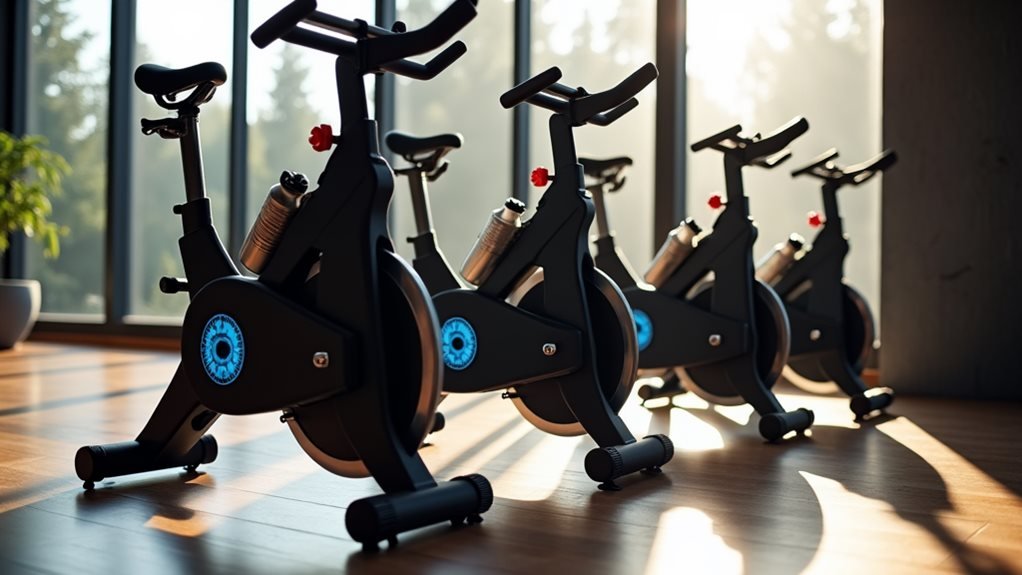
While smart technology enhances your cycling experience, mastering proper training techniques will maximize your results on a self-powered bike. I'll show you how to transform your workouts into high-performance sessions that deliver real results.
Start with proper positioning – it's non-negotiable. Set your seat at hip height and maintain a slight knee bend throughout your pedal stroke. Your back should tilt forward at a 45-degree angle for comfort, or 15 degrees if you're aiming for maximum power output.
Here's what your training progression should look like:
- Begin with a 5-10 minute dynamic warm-up, keeping your cadence smooth and controlled
- Move into your workout zones based on your threshold heart rate (THR)
- Finish with an active cool-down, skipping those outdated static stretches
For high-intensity work, I recommend starting with 30-second intervals at 75-90 rpm. Once you've mastered these, progress to pyramid workouts: 2×30 seconds, 2×45 seconds, and 2×60 seconds. Monitor your heart rate zones diligently – they're your best guide for peak training intensity and preventing burnout. Remember: proper form trumps speed every time.
Frequently Asked Questions
How Long Do Static Bike Seats Typically Last Before Needing Replacement?
I recommend replacing your bike seat after 400-600 hours of use, as the foam and materials deteriorate. You'll notice decreased comfort, even if you're not immediately aware of it.
Can Static Bikes Generate Enough Electricity to Power Household Devices?
I'd say they can power small devices like phones or LED bulbs – typically generating 150Wh per hour workout. It's not enough for major appliances though.
Are Static Bikes Safe for People With Knee Replacements?
Like a gentle stream, I'm happy to confirm that static bikes are very safe after knee replacement surgery. They'll help your recovery by providing low-impact exercise and improving range of motion.
What's the Average Noise Level in Decibels During Intense Static Bike Workouts?
I'd estimate most intense static bike workouts produce between 50-70 dBA, similar to normal conversation. Without mechanical resistance, they're fairly quiet even during vigorous pedaling sessions.
Do Static Bikes Require Annual Maintenance From Professional Technicians?
Like a car's yearly tune-up, I recommend annual professional maintenance for your bike. While I can handle basic upkeep, a technician maximizes performance and safety through specialized checks.
